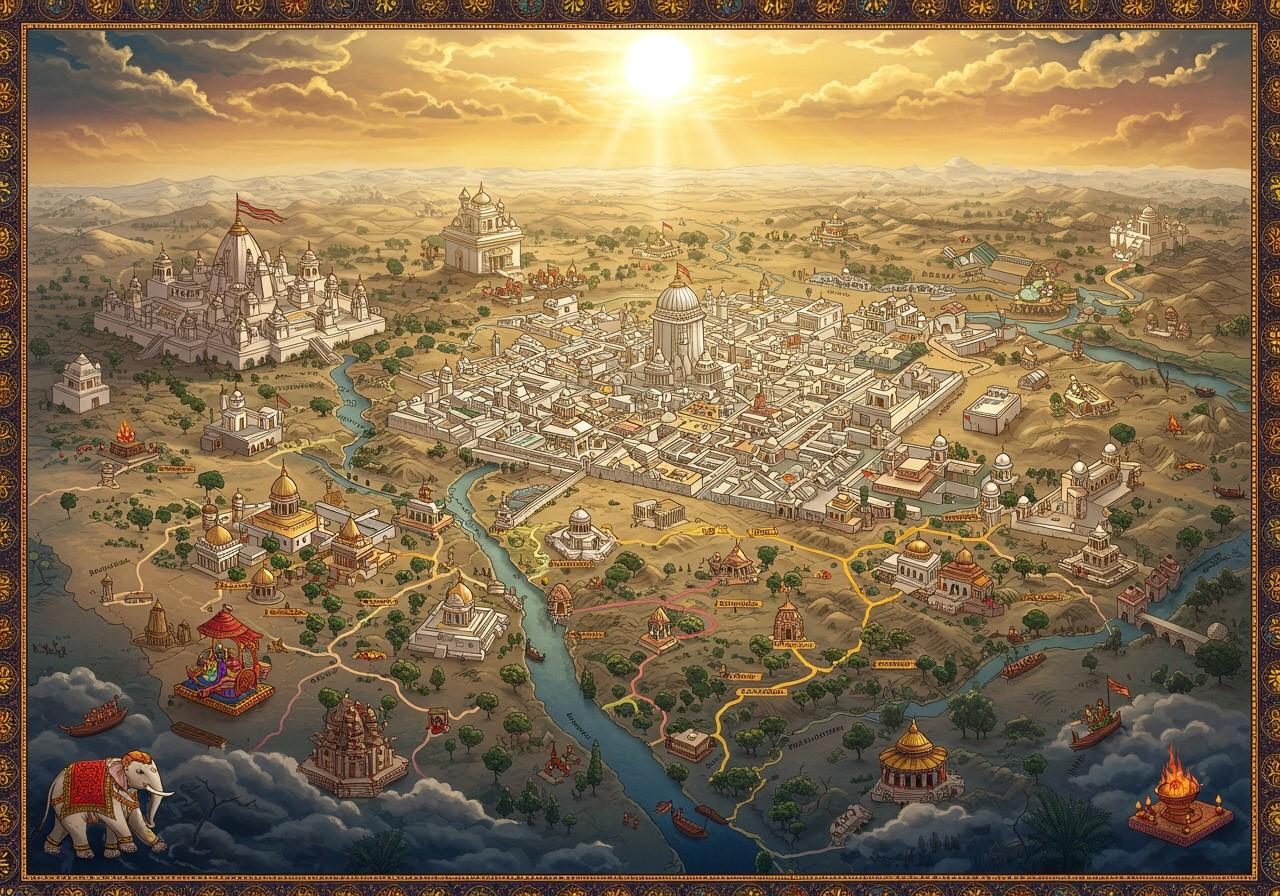
The Mahabharata, a cornerstone of Indian epic poetry, transcends mere storytelling. It unveils a rich tapestry of ancient Indian geography, offering a glimpse into the world where dharma and adharma clashed. This exploration delves into the significant locations of the Mahabharata, enhancing our understanding of its historical and cultural context.
The Kingdoms of the Mahabharata
The epic’s narrative unfolds across a network of kingdoms, each playing a pivotal role in the saga:
- Hastinapur: The capital of the Kuru kingdom, Hastinapur served as the epicenter of power struggles. It was the birthplace and battleground for the ambitions of both the Kauravas and Pandavas, witnessing their rise and fall.
- Indraprastha: Built by the Pandavas, Indraprastha symbolized their prowess and prosperity. This magnificent city became a testament to their architectural skills and administrative capabilities, marking their ascent to kingship.
- Dwarka: Founded by Krishna, Dwarka stands as a symbol of divine intervention and strategic brilliance. It showcases Krishna’s influence not only as a spiritual guide but also as a shrewd political strategist. Explore our collection of Laddu Gopal idols, reminiscent of Krishna’s divine presence.
- Panchala: Home to Draupadi, Panchala’s alliance with the Pandavas proved crucial. This kingdom’s strategic location and military strength significantly impacted the balance of power during the Kurukshetra War.
- Magadha: Renowned for its powerful rulers, Magadha’s strategic alliances shaped the political landscape. Its influence extended far and wide, impacting the decisions and destinies of other kingdoms in the Mahabharata.
- Matsya: Where the Pandavas spent their exile in disguise, Matsya represents resilience and resourcefulness. This kingdom provided refuge and a testing ground for their patience and strategic planning before the war.
- Gandhara: Ruled by Shakuni, Gandhara’s role highlights the complexities of political maneuvering. Shakuni’s influence and strategic advice to the Kauravas added another layer of intrigue to the epic’s narrative.
- Kashi (Kasi): Revered for its cultural and religious significance, Kashi’s mention in the epic underscores the spiritual depth of the era. This holy city served as a center of learning and philosophical discourse, further enriching the Mahabharata’s thematic tapestry.
Kurukshetra: The Battlefield of Dharma
Kurukshetra, the site of the climactic war, remains a place of immense significance:
- Location and Significance: Located in present-day Haryana, Kurukshetra, the “Land of Righteousness,” has witnessed numerous battles throughout history, solidifying its place as a significant historical and spiritual landmark. It is believed to be where the gods and sages once resided.
- The Bhagavad Gita: The profound dialogue between Krishna and Arjuna on this battlefield birthed the Bhagavad Gita, a timeless philosophical treatise offering guidance on duty, morality, and the pursuit of enlightenment.
- Archaeological and Mythological Significance: Archaeological findings and mythological references suggest Kurukshetra’s sanctity and significance as a chosen battleground due to its historical and spiritual weight. This adds to its enduring legacy as a place of great importance.
Beyond Kurukshetra: Other Significant Locations
The Mahabharata’s geographical scope extends beyond the battlefield:
- Rivers and Forests: The Ganges and Yamuna rivers, along with the Kamyaka forest, symbolize purity, sustenance, and the challenges faced by the Pandavas during their exile. These natural elements played a crucial role in shaping their journey.
- Mountains and Lakes: The Himalayas and Manasarovar lake represent spiritual quests and divine connections, highlighting the epic’s exploration of asceticism and the pursuit of higher knowledge.
- Other Key Locations: Sites like Varnavata, Rishikesh, Haridwar, and Prabhasa mark crucial events in the narrative, from near-fatal escapes to the final moments of Krishna, adding depth and complexity to the story.
Cultural and Historical Context
The geographical details within the Mahabharata offer valuable insights:
- Ancient India: The epic reflects the geographical knowledge of ancient India, encompassing diverse terrains, from rivers and forests to mountains and cities, showcasing a comprehensive understanding of the land.
- Political and Social Structures: The descriptions of kingdoms and their interactions reveal the complex political landscape and social dynamics of the time, highlighting alliances, rivalries, and the power structures at play.
Modern Connections and Sagar World Entertainment Map (2011)
The Mahabharata’s legacy continues to resonate:
- Pilgrimage and Tourism: Many locations mentioned in the epic are now revered pilgrimage sites, attracting devotees and tourists seeking to connect with the epic’s historical and spiritual significance.
- Mapping the Mahabharata: In 2011, Sagar World Entertainment created a detailed map visualizing the kingdoms of the Mahabharata. This map provides a valuable resource for understanding the geographical scope of the epic and the locations of key events. It depicts the political boundaries, rivers, forests, and other significant landmarks of the Mahabharata era.
Poojn.in: Connecting to the Mahabharata’s Spirituality
For those seeking to connect with the spiritual essence of the Mahabharata, Poojn.in offers a wide range of relevant products:
- Idols and Ritual Items: Find beautifully crafted idols of Lord Krishna, Laddu Gopal, and Radha Krishna, along with puja essentials like diyas, incense, and havan kund, to enhance your devotional practices.
- Sacred Texts and Books: Explore a collection of Mahabharata texts, commentaries, and related books to deepen your understanding of the epic’s philosophy and teachings.
Conclusion
The geography of the Mahabharata is not merely a backdrop; it’s an integral part of the narrative, enriching our comprehension of this timeless epic. By exploring these locations, we gain a deeper appreciation for the cultural, historical, and spiritual dimensions of the Mahabharata, connecting us to the values and beliefs that shaped ancient India.


